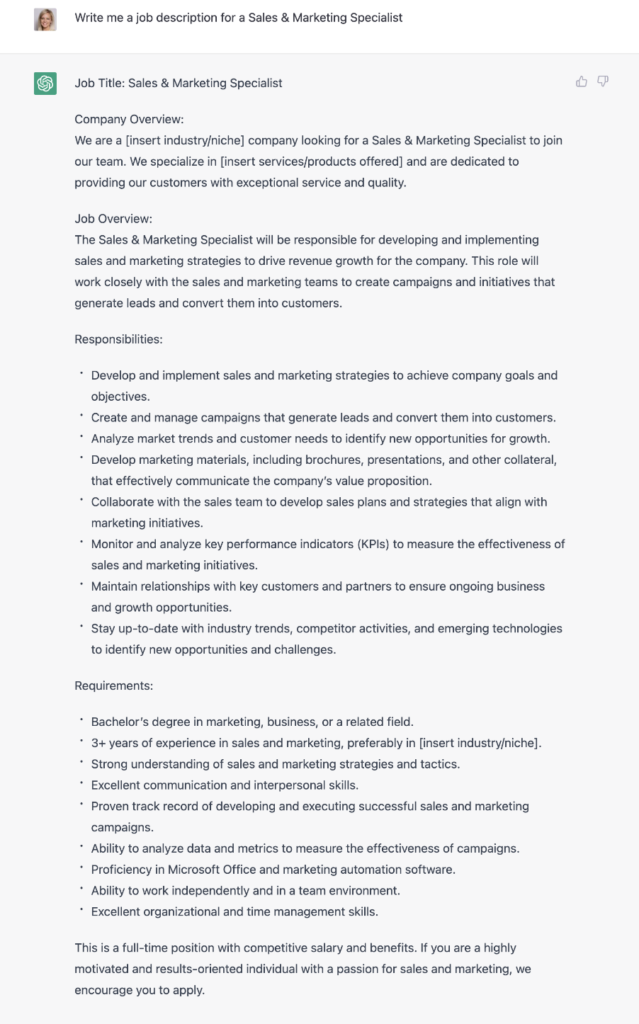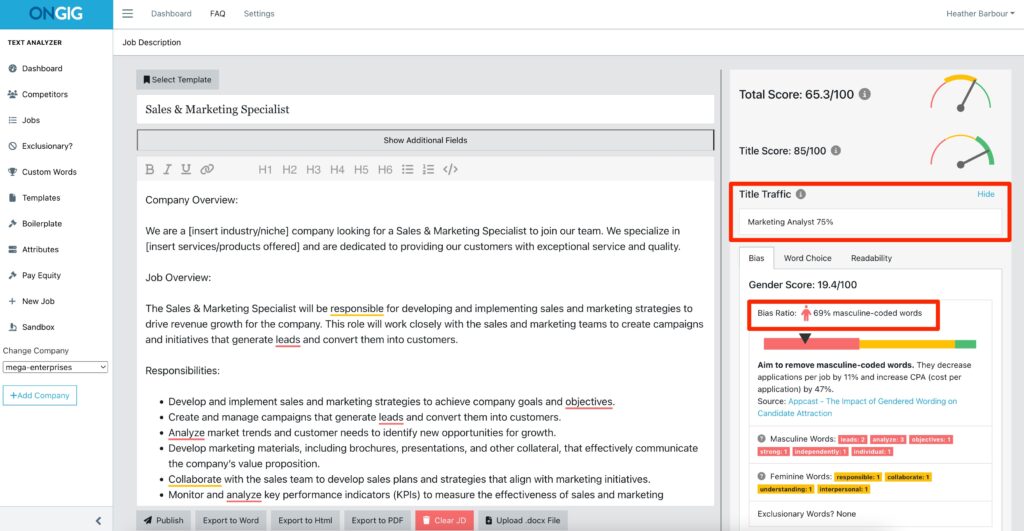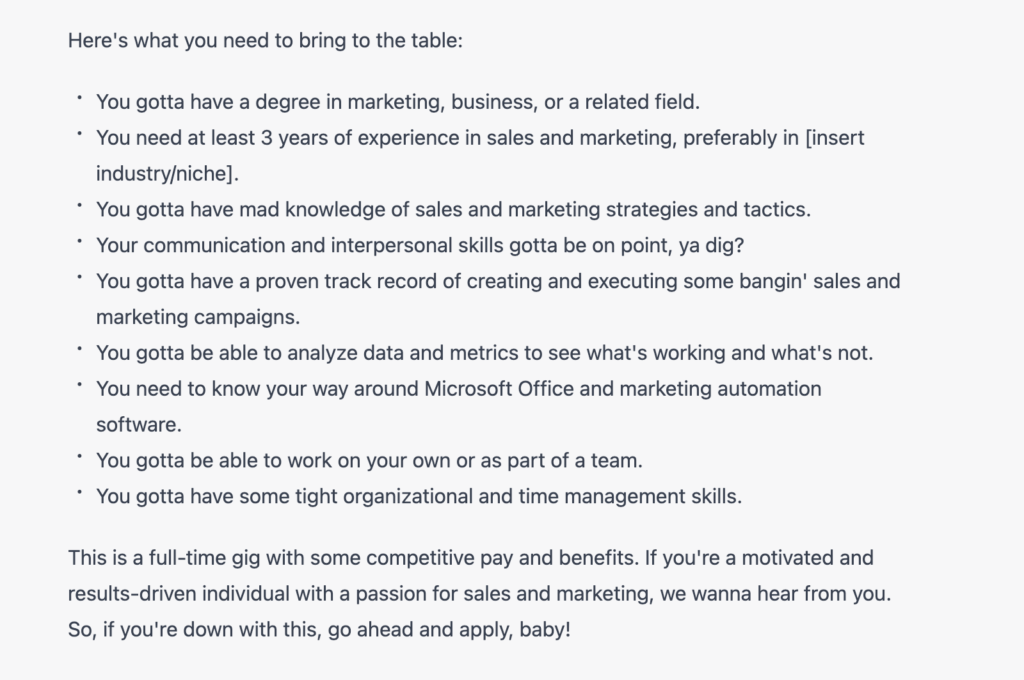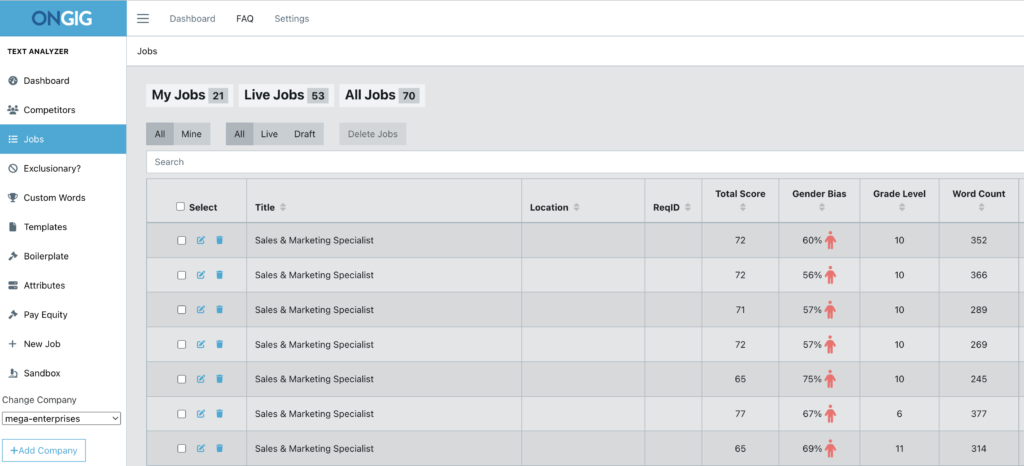
It seems ChatGPT for job descriptions is the “next big thing.” But is ai-written text great for writing the best JDs?
You can use it, but I recommend using it with other tools for optimizing job postings.
I did a test to show you why.
My first step was prompting OpenAI ChatGPT to “Write me a job description for a Sales & Marketing Specialist.”
In less than 30 seconds, I had a job description with a Company Overview, Job Overview, Responsibilities, and Requirements. I also got a short blurb about “competitive salary and benefits.”

Artificial intelligence models like Chat GPT are great at generating natural language text, so it’s easy to create job descriptions that are clear, engaging, and tailored to the target audience.
For example, ChatGPT can help draft great job descriptions by generating descriptive and informative language that effectively communicates the company overview, key responsibilities, and role requirements.
And, it can quickly produce job description drafts, freeing up your time for equally essential recruitment tasks like screening resumes and conducting job interviews.
Other benefits of using ChatGPT in crafting your job postings:
1. Check the grammar and style of your job description
ChatGPT can assist you in reviewing your job posts so they are grammatically correct and adhere to a consistent style and tone, making them more polished and professional.
For example, ChatGPT can check your job descriptions for spelling mistakes, punctuation problems, and stylistic inconsistencies so they are easier to understand and free of grammatical errors. It can also give recommendations to improve your sentence structure and tone to improve the readability of your text.
2. Generate a list of relevant keywords to optimize your job postings on search engines
ChatGPT can analyze industry trends, job boards, and competitor listings to help you identify relevant words and phrases to incorporate into your job descriptions. It can also give variations of these words like their plural forms and synonyms to expand your candidate reach and relevant searches.
For instance, for a software engineering role, it can suggest incorporating keywords such as “full-stack development,” “agile methodology,” or “cloud computing” to attract candidates with the desired skill set who are looking for the next job opportunity.
3. Make your job listing more creative and compelling
ChatGPT can inject copywriting and storytelling techniques into your job posts to make them more unique and memorable by offering creative suggestions and alternative phrasing for job descriptions.
For example, when crafting a job description for a marketing role, ChatGPT can suggest creative language and messaging that captures the excitement and innovation of the company’s marketing initiatives. It can help differentiate the job posting from competitors’ listings and trigger the interest of your potential candidates.
4. Customize your job descriptions to match your company voice and tone
You can instruct ChatGPT to tweak to reflect your company’s branding guidelines, tone and voice, resulting in a job posting that aligns with your overall messaging and values.
5. Translate your jobs (if it is English) to Spanish, Italian, etc.
If you are using an agency to translate your English-language JD into different languages, you can save time and money because ChatGPT can translate it for you accurately.
This is especially useful if you have global operations and want to recruit people to serve in different markets. You can use ChatGPT to translate your original English-written JD in Spanish, Korean, Chinese, etc.
Did ChatGPT Create the Best Job Descriptions?
When I first tried it, my initial thought was, “wow that’s fast!”
But, when I copied the text into Ongig’s Text Analyzer, I noticed a few issues/suggestions you won’t find in ChatGPT:
- Text Analyzer suggests you try using the job title “Marketing Analyst” — because 75% more people Google search that title each month than “Sales & Marketing Specialist.”
- The JD scored 19.4/100 for Gender Bias — because 69% of the words used are considered “masculine-coded.”
- The JD scored 56.9/100 for Readability — because it reads at a grade level of 11 and has sentences with more than 20-30 syllables.
- The “Requirements” section has more than 7 bullets — this may deter women and neurodivergent applicants from applying.
- The JD is missing some key sections candidates care about — Diversity & Inclusion, Flex Location, Mission Statement, etc.


This is why you should supplement ChatGPT with a tool like Text Analyzer. Yes, ChatGPT is fast, but some missing elements will likely affect your application rates, especially with diverse talent.
After my initial test, I dug deeper by giving ChatGPT more prompts to fine-tune the same job description.
For fun, I used the ChatGPT prompt “now write the same job description in the voice of Snoop Dog.”
Here’s what I got from trying to use AI to create the best job descriptions…


I found it interesting that this ChatGPT job description got the highest overall score out of the 7 outputs I used.
The overall score was 76.8/100, and it got a 100/100 for Readability because it reads at a 6.2-grade level (8th grade is ideal) and uses significantly few complex words and adverbs (the fewer of these you use, the better).
But, Text Analyzer still found some issues:
- The JD scored 22.5/100 for Gender Bias — because 67% of the words used are considered “masculine-coded.” Only a 2% drop from the original JD.
- The “Requirements” section has more than 7 bullets — Snoop Dog’s version still may deter women and neurodivergent applicants from clicking “apply.”
- The JD is still missing some key sections candidates care about — Diversity & Inclusion, Flex Location, Mission Statement, etc.
- The JD uses the potentially exclusionary word “mad” — Even though Snoop meant “mad skills,” as in “a lot of skills,”…the word “mad” might reinforce stereotypes of people with a mental health condition as “unwell” (especially in the UK).

The other 5 prompts I used to guide ChatGPT were:
- First prompt: “Now re-write the original job description to be more concise and readable.”
- Second prompt: “Now re-write this job description to remove masculine-coded words and bias.”
- Third prompt: “Now re-write this job description to include a real salary range and less “requirements””
- Fourth prompt: “Now re-write this job description, so it has between 300-700 words, no gender-coded words, or other biased words, a short list of requirements, and a section about salary and benefits.”
- Fifth prompt: “Now re-write this job description, so it is more conversational.”
Overall, ChatGPT mostly followed the prompts and improved the areas I asked about, but in all cases, the JDs still:
- Have a higher percentage of masculine-coded words than feminine-coded or neutral words
ChatGPT may have failed to 100% remove masculine-coded words because its language generation abilities depend on the data it has been on. If training data includes job descriptions with masculine-coded words, it may unintentionally have biases in its generated text.
It may also need to accurately identify and replace biased words, especially when specific phrases are deeply ingrained in traditional job descriptions. Without understanding the broader social and cultural implications of certain words, ChatGPT may reproduce biases present in the original texts.
- Still read at a grade level of 10 or higher (except for the Snoop Dog JD)
Suppose the original job description is too wordy or contains highly technical language. In that case, ChatGPT may struggle to simplify the text while maintaining its meaning and accuracy, and it may not understand the content thoroughly.
ChatGPT’s ability to rewrite text concisely and in a more readable way depends on its understanding of the context and intended audience. Without clear guidelines or context about the target readability level, ChatGPT may default to generating text at a higher grade level, assuming a certain level of familiarity with the subject matter.
- Were missing key sections like detailed salary & benefits information, diversity statements, and flex location (aka hybrid or remote work options)
It’s possible your ChatGPT prompt didn’t explicitly mention including these key sections in your job description. But, here are some possible reasons why each section might be missing:
- Salary and Benefits: these details might be considered confidential or depend on negotiation, so they might not be included in the training data
- Diversity Statements: If ChatGPT training data is older, it might not include a diversity statement, which is a relatively new addition to job descriptions
- Flexible Location: similar to the diversity statement, remote work options might be a new trend in job postings and not included in old training data

Based on my test, the use of ChatGPT is ok for JDs. But, I would not drop every job description tool to use ChatGPT alone. If you use it, try it in tandem with a tool like Text Analyzer to ensure your JDs are readable, effective, consistent, and bias-free.
Other ChatGPT Limitations when Crafting Job Descriptions
Cannot completely understand the context or finest details of the job role
ChatGPT’s inability to understand the nuances of a particular role can result in unclear job descriptions or failure to accurately convey the position’s requirements and expectations.
For example, when you prompt it to write a job description for a software engineer, ChatGPT may use technical language. Non-technical candidates may need help because they are unfamiliar with the job requirements. Without context, the job description might also fail to highlight the soft skills and other interpersonal qualities necessary for the role.
Unawareness of legal and compliance regulations related to job postings
ChatGPT may not know about employment opportunity guidelines (EEO) related to non-discrimination and diversity. It needs to be programmed to understand the intricacies of employment laws, which vary by location or region.
AI models often rely on generic templates for tasks like writing job descriptions. These templates might not be customized for specific industries or roles, potentially omitting crucial legal disclaimers.
For instance, if you hire a sales representative and your job requires long hours, you could violate overtime regulations depending on the location.
Lack industry-specific expertise
ChatGPT may need more expertise in specialized or technical fields, leading to accurate job descriptions. They may also misinterpret JD for roles that require domain-specific knowledge. In specialized fields or technical roles, additional input from subject matter experts may be necessary to describe job responsibilities and requirements correctly.
For example, writing a job description for a registered nurse requires an understanding of industry-specific regulations like licenses, certifications, and terminologies. ChatGPT may overlook these specific details, resulting in job posts that accurately represent the role’s requirements of the role or attract qualified candidates.
The descriptions might sound generic and fail to capture your company’s culture, mission, and values
Large language models like ChatGPT aren’t usually given access to the company’s internal information systems, so they can’t directly access documents or blogs explaining your company’s values or culture. ChatGPT usually relies on publicly available information like your social media posts or news articles, which may be incomplete or outdated, resulting in inaccurate conveying of your culture, mission, and vision.
Addressing ChatGPT’s Shortcomings
Fortunately, there are workarounds to ChatGPT’s limitations:
Train ChatGPT on diverse data
Train ChatGPT on different datasets that represent a wide range of position and language styles to improve its language generation functionalities and reduce bias in its output.
Use plain language
Use simple and straightforward language when giving instructions. Avoid technical jargon or complex terminology that could confuse the AI model and lead to less readable output.
Provide clear and specific prompts
Supply relevant contextual information about the job role, company culture, and ideal candidate profile. This helps ChatGPT to generate more accurate and customized job descriptions that resonate with your target job seekers.
For example, you can provide it with your company’s mission statement, links to your diversity page, career pages, relevant blog posts, or employee testimonials so it has accurate source material to work with.
Give feedback and examples
To clarify, you can give examples of well-written job descriptions and offer feedback on their generated output. You can highlight areas to improve, like readability, clarity, and inclusivity. You can also provide specific suggestions for revisions.
Use supplementary software to check your job descriptions
Use ChatGPT as a guide. You should always review and fine-tune your job description.
Use recruitment-specific tools like Ongig’s Text Analyzer to scan and review your JD for any biases or exclusionary words before publishing them.
Review your output
Go over your job descriptions and edit them as needed to make sure they are accurate, clear, and readable. Have your legal team check your JD to ensure they are compliant with employment laws and regulations.
Always include other HR professionals and hiring managers in the review process. They provide valuable insights into the role and ultimately, they make the final decisions during the hiring process.
Iterate and improve
AI like ChatGPT is constantly changing. So, provide ChatGPT with feedback and opportunities for iterative improvement. Don’t be afraid to experiment with different prompts, language styles, and formatting options to ensure your job descriptions remain relevant and competitive.
Why I Wrote This:
Ongig’s mission is to create effective and inclusive job descriptions. Part of that mission is to help improve your workflow so you can write the best JDs fast, and at scale. Please request a free demo if you’d like to learn more about Text Analyzer.
